Abstract
We monitored the modifications of oral and intestinal microfloras of 10 allogeneic bone marrow recipients who received randomly either norfloxacin or pefloxacin (400 mg three times a day) as selective decontamination for infection prevention. After 1 week of treatment, in all patients members of the family Enterobacteriaceae were no longer detectable and in all but one pefloxacin-treated patient enterococci were also eliminated in the intestine. The anaerobic flora was not affected, with the exception of Bacteroides spp., markedly reduced after treatment with pefloxacin. In most patients the most striking effect was the increase in staphylococcal counts. These strains were found to be resistant to both quinolones in the study. Less consistent changes were observed in oral flora. No relevant difference could be demonstrated between the two regimens on bacterial counts either in feces or in saliva. This study shows the efficacy of both quinolones in eradicating gram-negative bacilli in the alimentary tract of bone marrow transplant patients; however, the finding of the overgrowth of resistant gram-positive organisms during treatment with these agents deserves further evaluation.
Full text
PDF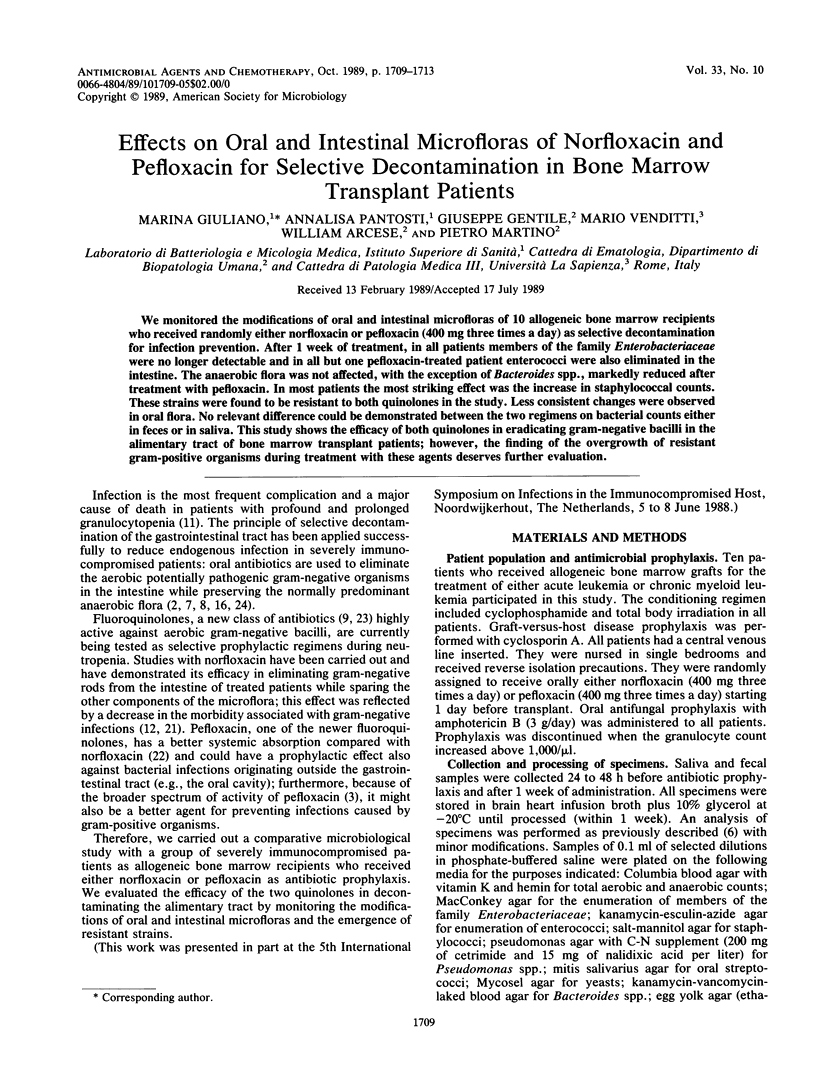
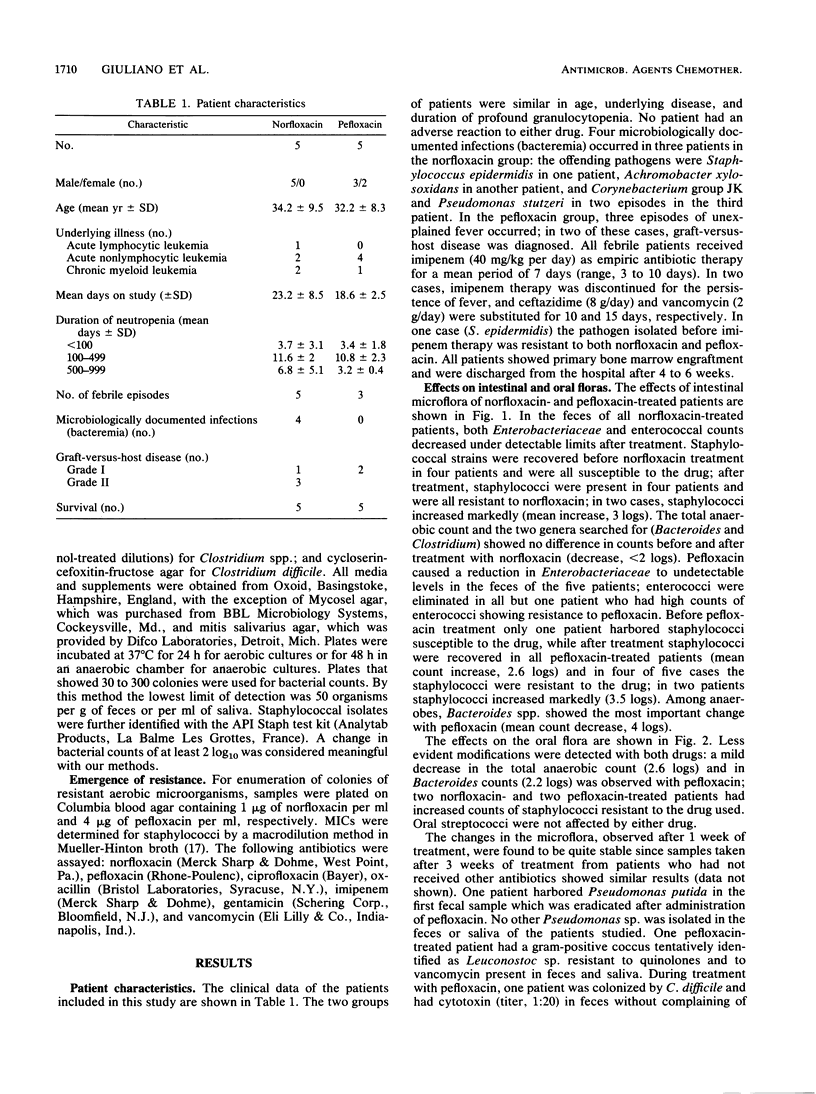
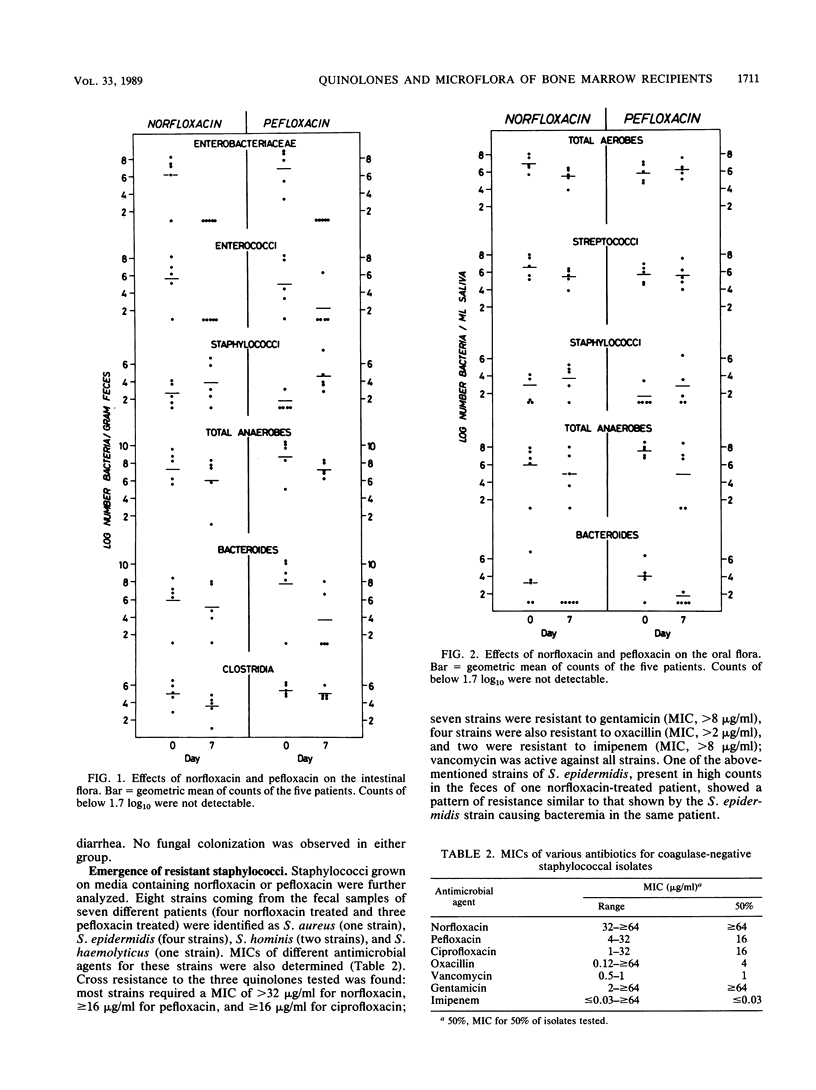
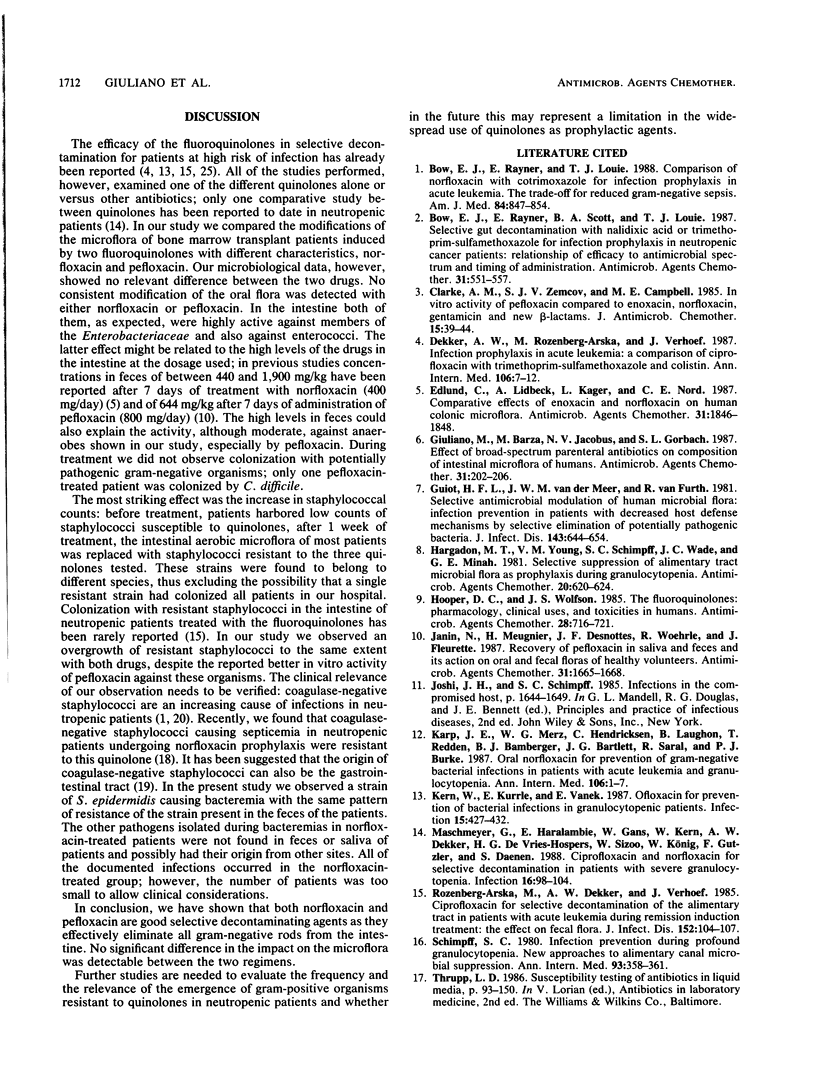
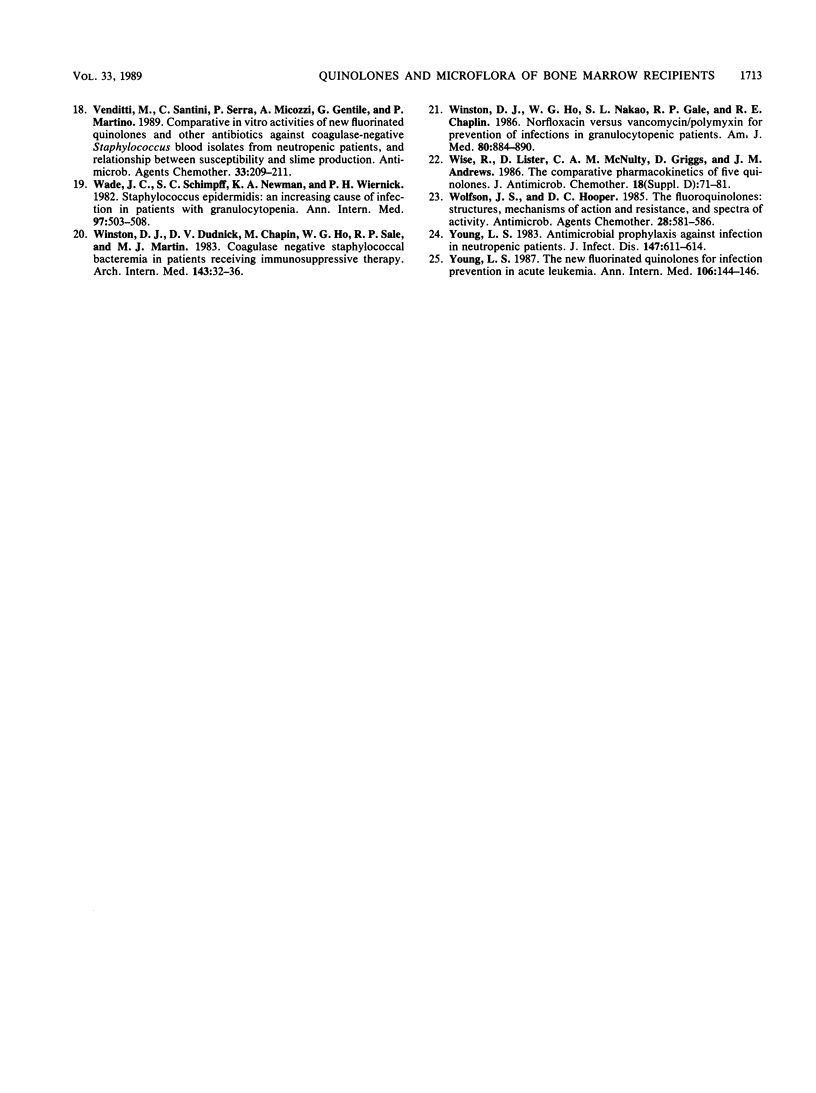
Selected References
These references are in PubMed. This may not be the complete list of references from this article.
- Bow E. J., Rayner E., Louie T. J. Comparison of norfloxacin with cotrimoxazole for infection prophylaxis in acute leukemia. The trade-off for reduced gram-negative sepsis. Am J Med. 1988 May;84(5):847–854. doi: 10.1016/0002-9343(88)90062-9. [DOI] [PubMed] [Google Scholar]
- Bow E. J., Rayner E., Scott B. A., Louie T. J. Selective gut decontamination with nalidixic acid or trimethoprim-sulfamethoxazole for infection prophylaxis in neutropenic cancer patients: relationship of efficacy to antimicrobial spectrum and timing of administration. Antimicrob Agents Chemother. 1987 Apr;31(4):551–557. doi: 10.1128/aac.31.4.551. [DOI] [PMC free article] [PubMed] [Google Scholar]
- Clarke A. M., Zemcov S. J., Campbell M. E. In-vitro activity of pefloxacin compared to enoxacin, norfloxacin, gentamicin and new beta-lactams. J Antimicrob Chemother. 1985 Jan;15(1):39–44. doi: 10.1093/jac/15.1.39. [DOI] [PubMed] [Google Scholar]
- Dekker A. W., Rozenberg-Arska M., Verhoef J. Infection prophylaxis in acute leukemia: a comparison of ciprofloxacin with trimethoprim-sulfamethoxazole and colistin. Ann Intern Med. 1987 Jan;106(1):7–11. doi: 10.7326/0003-4819-106-1-7. [DOI] [PubMed] [Google Scholar]
- Edlund C., Lidbeck A., Kager L., Nord C. E. Comparative effects of enoxacin and norfloxacin on human colonic microflora. Antimicrob Agents Chemother. 1987 Nov;31(11):1846–1848. doi: 10.1128/aac.31.11.1846. [DOI] [PMC free article] [PubMed] [Google Scholar]
- Giuliano M., Barza M., Jacobus N. V., Gorbach S. L. Effect of broad-spectrum parenteral antibiotics on composition of intestinal microflora of humans. Antimicrob Agents Chemother. 1987 Feb;31(2):202–206. doi: 10.1128/aac.31.2.202. [DOI] [PMC free article] [PubMed] [Google Scholar]
- Guiot H. F., van der Meer J. W., van Furth R. Selective antimicrobial modulation of human microbial flora: infection prevention in patients with decreased host defense mechanisms by selective elimination of potentially pathogenic bacteria. J Infect Dis. 1981 May;143(5):644–654. doi: 10.1093/infdis/143.5.644. [DOI] [PubMed] [Google Scholar]
- Hargadon M. T., Young V. M., Schimpff S. C., Wade J. C., Minah G. E. Selective suppression of alimentary tract microbial flora as prophylaxis during granulocytopenia. Antimicrob Agents Chemother. 1981 Nov;20(5):620–624. doi: 10.1128/aac.20.5.620. [DOI] [PMC free article] [PubMed] [Google Scholar]
- Hooper D. C., Wolfson J. S. The fluoroquinolones: pharmacology, clinical uses, and toxicities in humans. Antimicrob Agents Chemother. 1985 Nov;28(5):716–721. doi: 10.1128/aac.28.5.716. [DOI] [PMC free article] [PubMed] [Google Scholar]
- Janin N., Meugnier H., Desnottes J. F., Woehrle R., Fleurette J. Recovery of pefloxacin in saliva and feces and its action on oral and fecal floras of healthy volunteers. Antimicrob Agents Chemother. 1987 Nov;31(11):1665–1668. doi: 10.1128/aac.31.11.1665. [DOI] [PMC free article] [PubMed] [Google Scholar]
- Karp J. E., Merz W. G., Hendricksen C., Laughon B., Redden T., Bamberger B. J., Bartlett J. G., Saral R., Burke P. J. Oral norfloxacin for prevention of gram-negative bacterial infections in patients with acute leukemia and granulocytopenia. A randomized, double-blind, placebo-controlled trial. Ann Intern Med. 1987 Jan;106(1):1–7. doi: 10.7326/0003-4819-106-1-1. [DOI] [PubMed] [Google Scholar]
- Kern W., Kurrle E., Vanek E. Ofloxacin for prevention of bacterial infections in granulocytopenic patients. Infection. 1987 Nov-Dec;15(6):427–433. doi: 10.1007/BF01647222. [DOI] [PubMed] [Google Scholar]
- Maschmeyer G., Haralambie E., Gaus W., Kern W., Dekker A. W., De Vries-Hospers H. G., Sizoo W., König W., Gutzler F., Daenen S. Ciprofloxacin and norfloxacin for selective decontamination in patients with severe granulocytopenia. Infection. 1988 Mar-Apr;16(2):98–104. doi: 10.1007/BF01644312. [DOI] [PubMed] [Google Scholar]
- Rozenberg-Arska M., Dekker A. W., Verhoef J. Ciprofloxacin for selective decontamination of the alimentary tract in patients with acute leukemia during remission induction treatment: the effect on fecal flora. J Infect Dis. 1985 Jul;152(1):104–107. doi: 10.1093/infdis/152.1.104. [DOI] [PubMed] [Google Scholar]
- Schimpff S. C. Infection prevention during profound granulocytopenia. New approaches to alimentary canal microbial suppression. Ann Intern Med. 1980 Aug;93(2):358–361. doi: 10.7326/0003-4819-93-2-358. [DOI] [PubMed] [Google Scholar]
- Venditti M., Santini C., Serra P., Micozzi A., Gentile G., Martino P. Comparative in vitro activities of new fluorinated quinolones and other antibiotics against coagulase-negative Staphylococcus blood isolates from neutropenic patients, and relationship between susceptibility and slime production. Antimicrob Agents Chemother. 1989 Feb;33(2):209–211. doi: 10.1128/aac.33.2.209. [DOI] [PMC free article] [PubMed] [Google Scholar]
- Wade J. C., Schimpff S. C., Newman K. A., Wiernik P. H. Staphylococcus epidermidis: an increasing cause of infection in patients with granulocytopenia. Ann Intern Med. 1982 Oct;97(4):503–508. doi: 10.7326/0003-4819-97-4-503. [DOI] [PubMed] [Google Scholar]
- Winston D. J., Dudnick D. V., Chapin M., Ho W. G., Gale R. P., Martin W. J. Coagulase-negative staphylococcal bacteremia in patients receiving immunosuppressive therapy. Arch Intern Med. 1983 Jan;143(1):32–36. [PubMed] [Google Scholar]
- Winston D. J., Ho W. G., Nakao S. L., Gale R. P., Champlin R. E. Norfloxacin versus vancomycin/polymyxin for prevention of infections in granulocytopenic patients. Am J Med. 1986 May;80(5):884–890. doi: 10.1016/0002-9343(86)90633-9. [DOI] [PubMed] [Google Scholar]
- Wise R., Lister D., McNulty C. A., Griggs D., Andrews J. M. The comparative pharmacokinetics of five quinolones. J Antimicrob Chemother. 1986 Nov;18 (Suppl 500):71–81. doi: 10.1093/jac/18.supplement_d.71. [DOI] [PubMed] [Google Scholar]
- Wolfson J. S., Hooper D. C. The fluoroquinolones: structures, mechanisms of action and resistance, and spectra of activity in vitro. Antimicrob Agents Chemother. 1985 Oct;28(4):581–586. doi: 10.1128/aac.28.4.581. [DOI] [PMC free article] [PubMed] [Google Scholar]
- Young L. S. Antimicrobial prophylaxis against infection in neutropenic patients. J Infect Dis. 1983 Apr;147(4):611–614. doi: 10.1093/infdis/147.4.611. [DOI] [PubMed] [Google Scholar]
- Young L. S. The new fluorinated quinolones for infection prevention in acute leukemia. Ann Intern Med. 1987 Jan;106(1):144–146. doi: 10.7326/0003-4819-106-1-144. [DOI] [PubMed] [Google Scholar]


